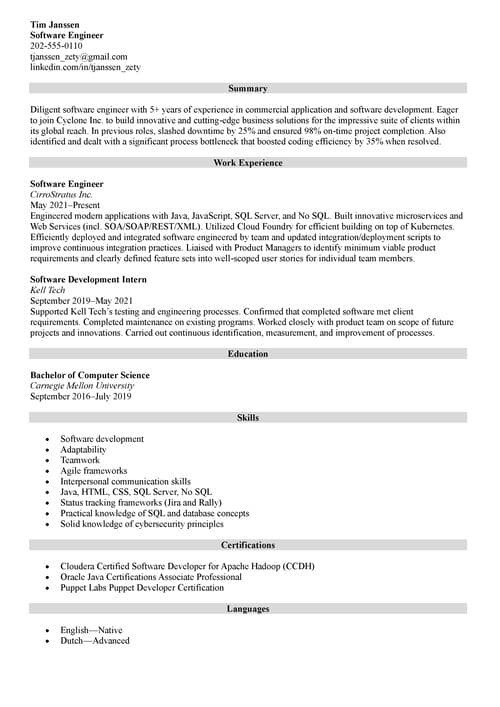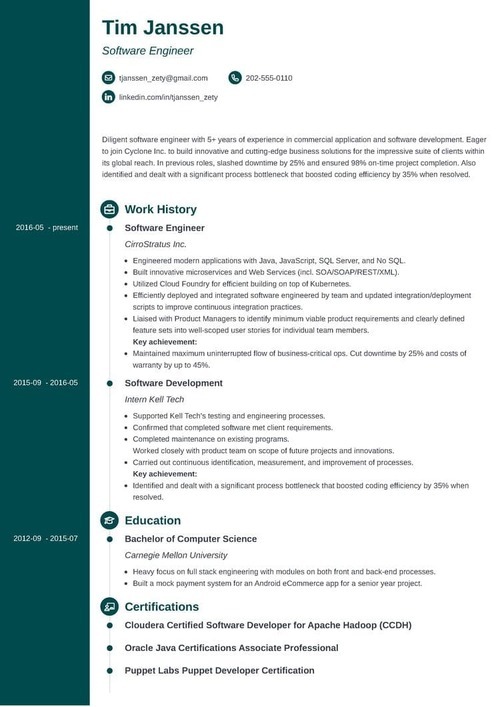


Can you network your way into a $100,000 job—in your 20s—with no degree?
It’d be awesome, wouldn’t it?
Well, it’s not just a pipe dream. That’s basically what Elle Torres did. “In 4 years I went from $15/hr to a six-figure job,” says Torres. She did it through networking and accomplishments before finishing her degree.
How did she do it? It’s not what you think.
Want to save time and have your resume ready in 5 minutes? Try our resume builder. It’s fast and easy to use. Plus, you’ll get ready-made content to add with one click. See 20+ resume templates and create your resume here.


Sample resume made with our builder—See more resume examples here.
1
When I say “networking,” chances are you hear “pestering people.” That’s not how Torres got that six-figure job. She started in a call center for a major healthcare company—today’s equivalent of the mailroom. The salary? $25,000 a year.
Her first goal? Get out of the call center and into the hospital setting. The easiest way was to target an area with high turnover. “I took one of the million open clerk positions that seemed to be perpetually open,” Torres explains.
Next, she did one small thing differently from her peers. “I made simple but noticeable improvements wherever I went,” Torres says. That started with an employer-sponsored class in process improvement.
“I tried my hand at running a small project,” says Torres. “With a budget of 20 man-hours and $1,000 or less, I took the emergency department from averaging $30K or less each year to six figures a month. How? Networking.”
Torres didn’t know how to make an emergency department 100 times more profitable. But—
She realized other people might. In her class, she met a wide range of professionals throughout the organization. One was a veteran clinician. “A conversation with him gave me instant street cred with the staff, which was the support I needed to move my project through.”
That success earned the attention of the CFO and resulted in a position at a name-brand firm making $50,000—double her previous income.
The new job opened the door to for even higher-value connections, leading to yet another offer at $60K+ per year. Her focus on adding value quickly got her promoted to senior management—not 18 months since earning $15/hr.
Then, disaster struck.
A massive round of layoffs destroyed Torres’s new dream job. The career she’d poured her heart and soul into was gone in 15 minutes.
But something miraculous happened.
“I found my inbox jammed with meeting requests from the connections I had made,” Torres says.
Most of the job offers would have meant a step backward. Still, she followed up with every call, text, or email. That strengthened the network she’d worked so hard to build.
One of those connections told her about a high-level opening. She found out what the position required and tailored her resume to match.
Torres landed the unlisted position with a top tier healthcare company. The salary? A six-figure base and a very generous bonus package.
Why did I emphasize “unlisted?”
Because she couldn’t have got it without networking.
Nobody could.
How did Torres work this miracle?
She learned very quickly to do two things:
I’ll show you how she did that next.
2
If you had unlimited time, you could network with everybody in your field.
You don’t.
Networking sounds exhausting, doesn’t it? To most, it conjures images of sending a barrage of spam emails to people who don’t want to talk to you.
Torres put her efforts somewhere else.
First, Torres learned to spot key people at work.
In any organization, there are people who move the business and people who are only there to punch the clock.
“There are many circumstances where the manager or director influences a decision more than any executive,” Torres says. “It’s important to connect with the people who actually spark change, and not just the embodiment of some intimidating title.”
Does a decision-maker ask for time to consult with someone before making a decision?
“The biggest tell in my opinion, is verbiage. If a phrase keeps popping up in conversation, a few well-timed questions will reveal the source. That’s the influencer.”
A classic real life example? When an executive or upper-level manager suddenly changes his or her mind on a key issue, there’s probably an influencer at work.
“Or if the executive suddenly starts working the phrase ‘synergistic approach’ into every meeting despite never using that term before, ask him to elaborate,” says Torres.
That might lead you to an employee who’s been a personal friend of the executive for 20 years.
Torres also learned to find key people at companies she wanted to work for. Her biggest asset? LinkedIn.
She uncovered key leaders by studying their companies. She also learned of them by reading articles about the industry.
“It matters less who you’re connected to,” says Torres, “and more whether you share the right connections with the individual you’re hoping to meet.”
3
Once Torres picked the right people to network with, she reached out.
“I might send a note with a line or two of how I know them, or why I want to,” Torres says. She leaves her contact info and an open invite, but rarely requests a call.
“Honestly, a request for a call will be almost universally ignored,” Torres says. “I’m annoyed when I see it from someone I barely know, especially if they’re not in a position to add value.”
When making a resume in our builder, drag & drop bullet points, skills, and auto-fill the boring stuff. Spell check? Check. Start building a professional resume template here for free.
When you’re done, Zety’s resume builder will score your resume and tell you exactly how to make it better.
4
Torres’s most important lesson? Once you connect, find a way to matter.
First, she tries to think of ways to help.
Try to learn your contact’s challenges. Listen to them complain—online, at conferences, at work, or at social events.
“I’d reference my own success in solving a similar scenario,” says Torres, “and offer free advice in a non-confrontational, informal setting.”
It all boils down to helping others succeed, then not trying to take credit.
“Winning over that influencer is about letting them tell the story, and helping them come to the right conclusion,” says Torres. “If they feel like it’s their idea, then they’re likely to do your work for you to gain leadership support.”
Can’t solve their problem? “Then I would go for the next best thing,” Torres says, “introduce them to another connection who’s an expert in that area, or offer resources to accelerate their success.”
Employers don’t need geniuses. They need solutions. The quickest way to get hired? Be a never-ending wellspring of solutions. The ideas don’t all have to come from you.
Can’t fix their problem? Find key interests. Maybe you’re both interested in golf, rock climbing, or a certain author.
“If they mention a book they liked,” Torres says, “respond with your (brief) thoughts on it and ask intelligent questions.” That lets them show off without outright bragging.
If you can do the above, you’ll dig up that most valuable of job search gold—internal referrals.
Steve Dalton, Duke University Daytime Career Services Director and author of The 2-Hour Job Search, explains.
“We’re operating in a trust economy,” says Dalton. “There are plenty of qualified candidates. But finding one that I trust, that's the hard part. That's important. If I already like you it takes a lot of data for me to override my first impression.”
Pro Tip: None of these networking methods will work if you discredit yourself. Don’t volunteer information on any area of interest where you don’t know your stuff.
5
Does all this providing value sound exhausting?
If you’re not in a position to help, fall back on informational interviews.
According to Steve Dalton, networking is really just another word for “getting internal referrals.”
”There’s great research by Olivia Fox Cabane who wrote a book called The Charisma Myth,” Dalton says. “She found that the single biggest predictor of charisma is nothing that you actually say. It's how well you’re perceived to be listening.”
So—once you find the right people, ask for a call, then don’t talk. Ask about their career, what they’re working on that’s great—anything that lets them strut their stuff.
“Success in your job search means bringing people's guards down,” Dalton says. “You need them to advocate for you––even though there's absolutely nothing in it for them. It's so much easier to call somebody up and say, hey, your job seems really cool, Would you mind telling me about how great it is and how you do it? Who doesn't want to say yes to that?”
Plus, a great cover letter that matches your resume will give you an advantage over other candidates. You can write it in our cover letter builder here. Here's what it may look like:
See more cover letter templates and start writing.
6
This is networking.
It’s not pestering people.
It’s finding the right people, then providing value and/or finding common ground.
In short, it’s helping people. It’s building real relationships. It makes you more valuable in your current job and more in-demand with external employers.
Dale Carnegie and Zig Ziglar—two of the greatest networkers of all time—both give the same advice: You can get anything you want—if you help enough other people get what they want.
Stay true to that, and you’ll get any job you set your sights on.
Got questions? Want to share your networking story? We can’t wait to hear your thoughts! Drop us a line in the comments and we’ll get back to you right off. Let’s chat!
The best resume templates aren't just about fancy looks. They have to be sleek and professional. Their layout needs to show off your value. Here's what'll help.
Think you know how to use Google? Think again. Better yet, read this article. Learn the best Google search hacks you've missed out on. Get better results and boost your productivity in 2023.
Interview coming up, and you just don’t know what to expect? Here’s a compilation of the most common interview questions that you might hear and how to answer them.

![40+ Google Search Hacks, Tricks & Tips for 2023 [Infographic]](https://cdn-images.zety.com/pages/google_search_hacks_2.jpg?fit=crop&h=250&dpr=2)
